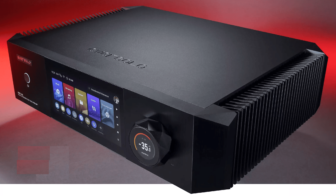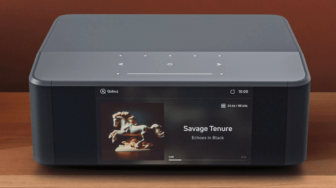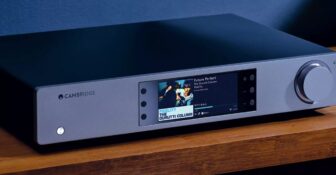WiiM Ultra Review
WiiM has made a name for itself with almost shamelessly affordable streamers. The new Amp Ultra is a bit more expensive but is still said to be great value for what it offers—so what can it do?
Text: Julian Holländer
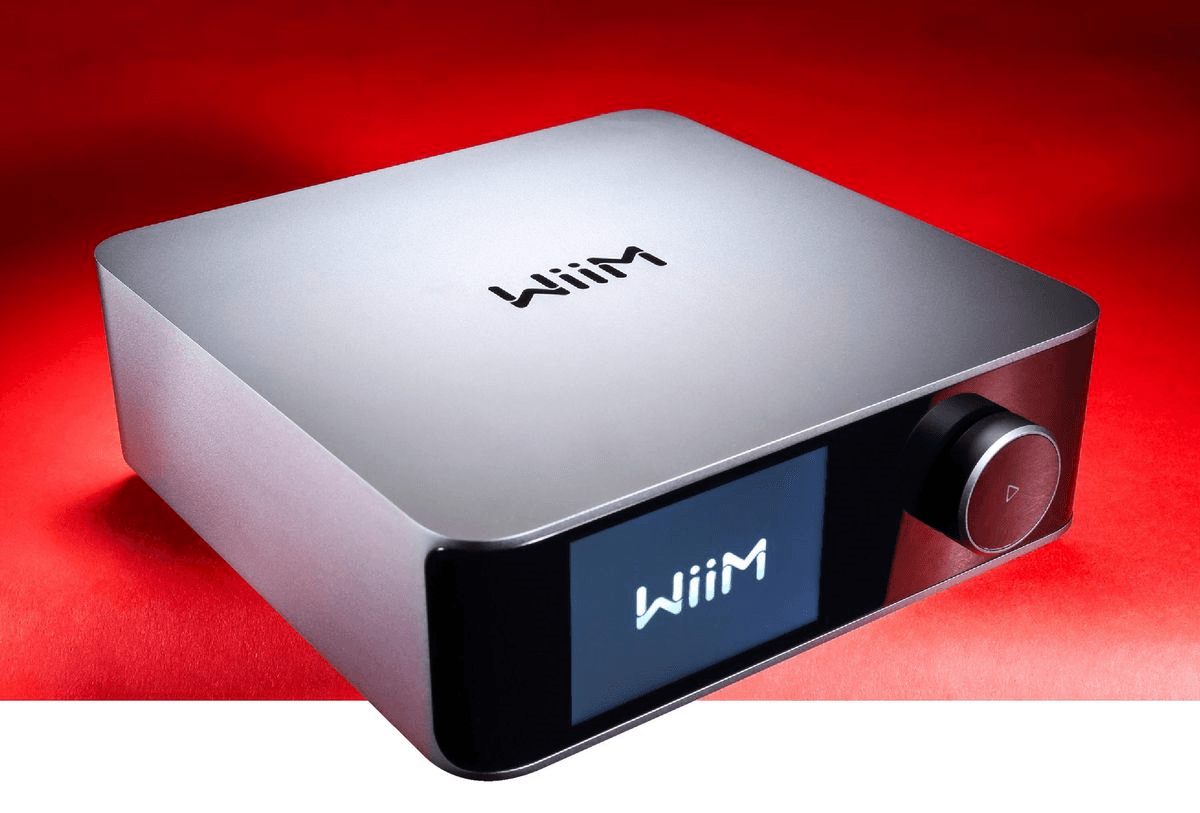
For WiiM fans, the name of this new device already hints at its purpose: “Amp Ultra.” For everyone else, here’s a quick intro—the company’s naming is pleasantly simple. “Amp” tells you it’s an integrated amplifier, and “Ultra” signals a flagship while also linking it to the visually similar WiiM Ultra. That one is a network streamer, so the logical conclusion is that the Amp Ultra is a streaming amplifier—and currently WiiM’s top model.
The first task is to figure out where the “Amp” part and the “Ultra” part overlap. One might expect the Amp Ultra to be a variant of the smaller “Amp” with a screen like the Ultra. But it’s actually quite its own thing, while naturally borrowing a lot of know-how from both—and really all—WiiM devices.
A small detail—also the only real shortcoming in the digital spec list—suggests it leans a bit more toward the concept of “Ultra streamer with a power amp.” The new amplifier from WiiM does not support AirPlay, just like the Ultra streamer. The original Amp, however, understands Apple’s wireless protocol. Given AirPlay’s Apple exclusivity and lack of true hi-res support, we think this omission is easier to accept than, say, losing Google Cast or the Connect protocols from Spotify, Tidal, and Qobuz—all of which are supported.
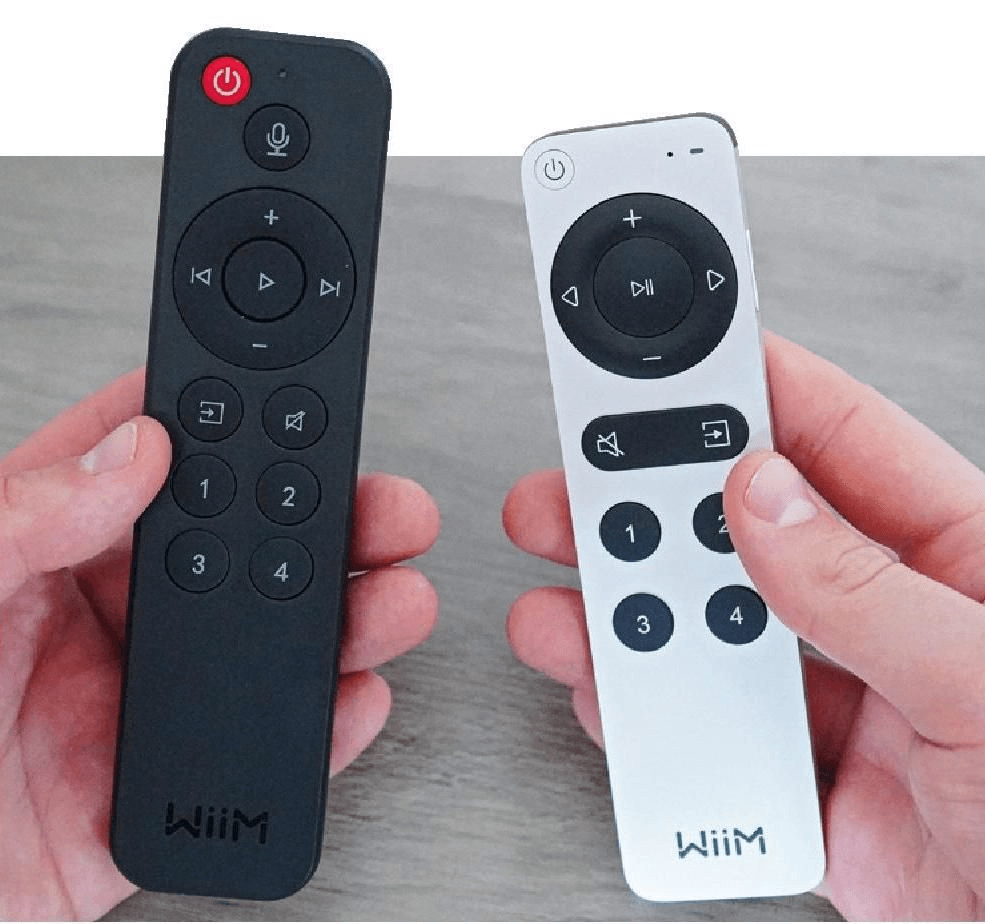
The Amp Ultra introduces the new remote (right). Improvements: USB-C charging, a side microphone button, and a metal finish.
No phono, but almost everything else
There are a couple of omissions compared with the Ultra and a “perfect” device: no headphone jack and no phono input. The latter isn’t exactly expected in a streaming-focused product but can be a nice bonus. In practice, this isn’t dramatic—most modern turntables in the appropriate price range have a built-in phono stage, and with around €100 (about $) you can find separate phono pres that may already be on a higher level.
One possible reason for the missing phono input: the back panel is simply full. Alongside the speaker terminals and power socket, you get one analog input, an optical input for digital sources, and HDMI ARC for TVs. If you use a third-party subwoofer—the upcoming WiiM “Sub Pro” will connect wirelessly—you’ll find a sub out plus app settings for delay and crossover. There’s also a USB port for external DACs. And even though it’s not explicitly stated in the spec sheet, we were able to connect a USB drive with music and stream its files to other WiiM players on the network.
The speaker outputs use an unusual solution. WiiM clearly aims for a flat rear panel, so the binding posts are recessed, letting banana plugs slide straight in. For everything else, including bare wire, the box includes four adapters that plug into these terminals.
To ensure the signal feeding those terminals is high quality, the internals aim to impress. Borrowed from the Amp Pro is the “post-filter feedback technology,” which is designed to automatically adapt output to different speaker loads—delivering consistently low-distortion, natural sound with any speakers. Thermal management—aluminum heatsink, a copper heat pipe for heat dissipation, and real-time monitoring—also helps the amp maintain performance under demanding conditions.
Top DAC and plenty of power
For a sonic upgrade, WiiM uses ESS’s ES9039Q2M DAC chip here for the first time, a notch above the ES9038Q2M in the Ultra and Amp Pro. This enables playback of hi-res files up to 32-bit/384 kHz and aims to ensure top-tier conversion quality. Bluetooth is on board too—and bidirectional—so it can even send music to headphones.
Unlike the Amp, the Ultra has a dual Texas Instruments Class-D output stage, which promises a lot—including ample power for all typical use cases. We measured 115 W continuous into 4 ohms at 1% THD and 167 W peak power—pretty solid numbers that should be more than enough for any realistic partner speakers. Measurement results are strong overall, whether the input is digital or analog. An analog input signal isn’t “harmed” by being converted to digital—a prerequisite for applying EQ to it.
Otherwise, the Amp Ultra keeps everything “as usual” with the WiiM platform—the underlying digital system for music streaming, control, and multiroom, which ranks among the best in all these aspects. Part of WiiM’s success is the speed at which this system—and thus all devices—receive updates.
Extremely detailed room correction
In addition to continuous improvements in usability, UI, and navigation, WiiM’s parent company Linkplay keeps refining the now quite powerful equalizer. The biggest addition some time ago was full-blown room correction, which has been further optimized and now goes by the name “RoomFit.”
You can set many parameters (e.g., frequency range or target curve preset) and even measure both channels separately. The result is stored as a preset in the parametric EQ, where you can tweak it at will. Measurements can be done with your phone’s mic or an external mic connected to it—if possible, we recommend the latter with a quality measurement mic. Even with just a phone, though, it improved the sound for us; without any manual tweaks it sounded more balanced and rounded, albeit with a slight trade-off in spaciousness.
The Amp Ultra is also the first WiiM device with the second generation of its remote. Thanks to Bluetooth, it controls the unit regardless of angle. Functionally it’s the same as the first version: basic controls, preset buttons, and—nice touch—optional voice control. The voice button is now on the side for better ergonomics, and the whole remote feels more premium thanks to its metal finish.
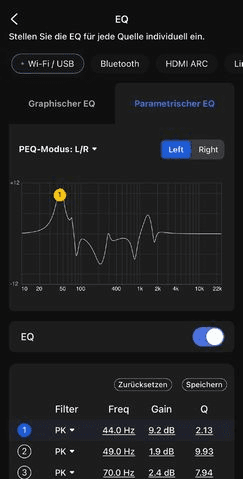
The result of the room correction can be flexibly adjusted in the versatile app.
Another improvement: it no longer needs batteries—the built-in battery charges via USB-C. Very practical, though as is typical in this segment, the remote will usually remain the second control option behind the app. Either way, the compact touchscreen also helps, offering basic control, album art, or even a VU meter.
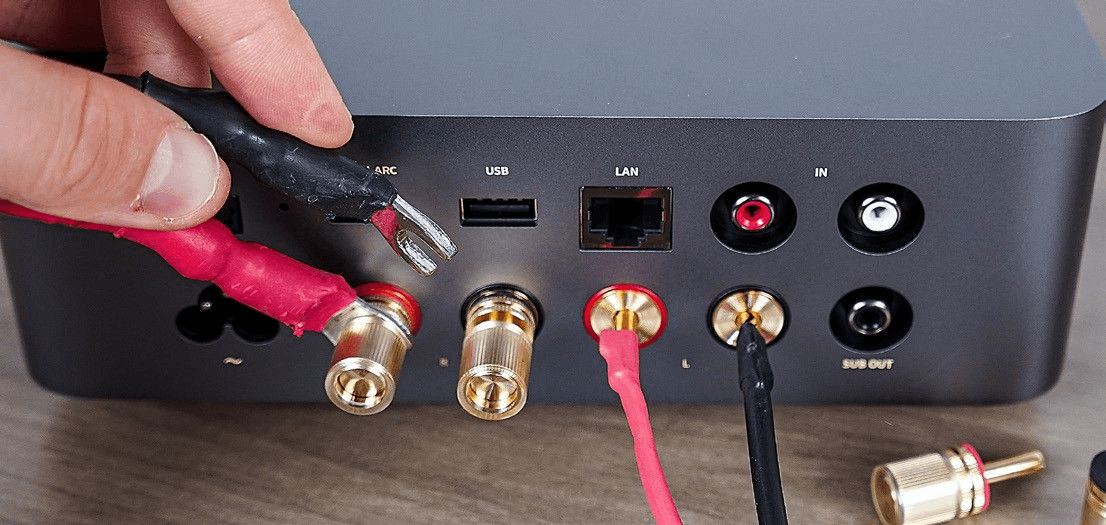
Banana plugs can be inserted directly into the WiiM (right); practical adapters are included for spades or bare wire (left). The optical and HDMI inputs are hidden by the cables here.
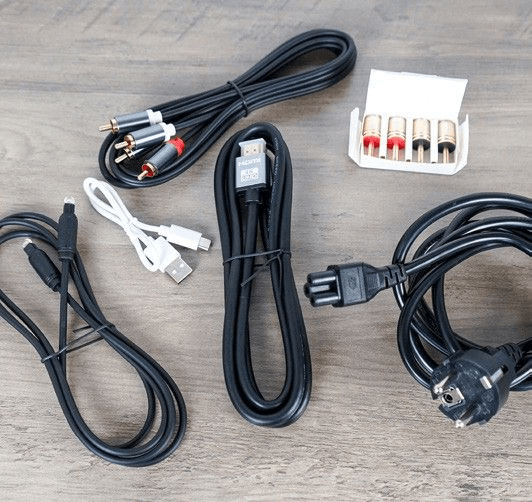
With numerous cables in the box, everything is ready for a quick start.

The WiiM screen offers many display options, from informative to VU meter.
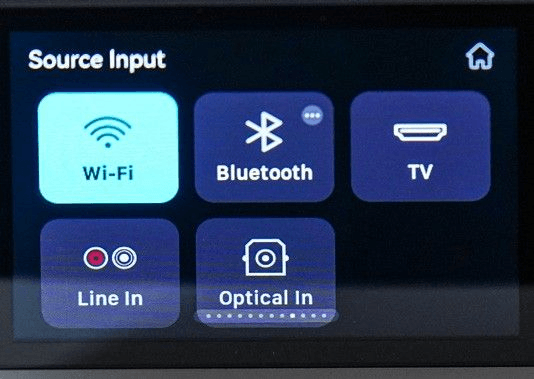
Input selection or EQ preset selection also works on the small but fine display.
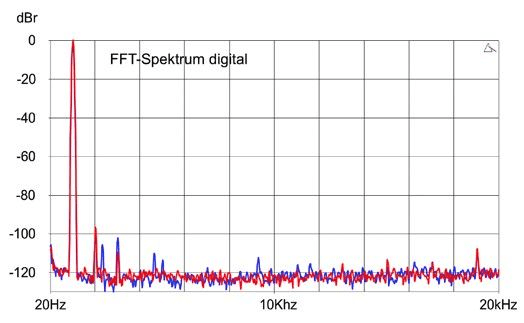
In measurements, the Amp Ultra performs very well, both with digital and analog input.
Flexible sound with definition
It quickly becomes clear that the extra effort here pays off. The Amp Ultra doesn’t just get music onto your speakers—it makes it sound very good, especially for the price. Thanks to healthy power reserves, it delivers clean, fast transients with common and even pricier speakers, and it presents a wide soundstage.
Even with the hectic mix of jazz, rock, and piano on Ron Minis’ “The Aggregate,” the WiiM keeps its composure, rendering hi-hats and keystrokes crisply and portraying instruments naturally. Tonal neutrality is on point, and vocals keep their charm. If you’re looking for room to improve, you might find it in foundation and fullness. While the WiiM is capable of solid punch, it leans more precise-lean and less rich-weighty. Bigger and more expensive amps—sometimes not dramatically more expensive, though without the WiiM platform—can deliver more of that.
The newcomer brings all the platform benefits, even if, as a streaming amp, it doesn’t include every feature of a classic amplifier. You can get it cheaper with the Amp (Pro), but compared to those, the Ultra makes a visual, tactile, and quality step forward with its screen, new remote, and better components. It’s entering a space with more competition—but it pairs well with virtually any speakers, offering good power, nice definition, and a natural sound, making it a top offering at its still-low price.
Product & pricing
Type / price class: Integrated amplifier with streaming; €500–€1,000 (≈ $540–$1,080)
Website / price: wiim-audio.de — €599 (≈ $647)
Size / weight: 20 × 7.4 × 20 cm, 2.4 kg
Germany distributor / phone: ATR Audio Trade (audiotra.de) / +49 208 882660
Sound
Sound quality (comment): Neutral and precise with good power reserves, could be a bit more full-bodied.
Measurements
Continuous power @ 4 Ω, 1% THD: 115 W (good)
Peak power @ 4 Ω, 1 kHz: 167 W (good)
Intermodulation @ 5 W: 0.00091 % (very good)
Damping factor @ 4 Ω / Channel separation: 46 (good) / 81 dB (very good)
Volume control channel balance: 0.06 dB (very good)
Upper cutoff frequency: 54 kHz (satisfactory)
THD @ 5 W: 0.004 % (very good)
SNR @ 5 W: 89 dB (satisfactory)
Idle power draw: 16 W (very good)
Features
Build & finish: Good
Analog inputs (RCA/XLR): 1 × RCA
Special interfaces: Bluetooth, HDMI (ARC), optical, Sub-Out
Tone control / room correction: Yes
Pre-out / colors: No / gray, silver
Streaming standards: Google Cast, Spotify/Tidal/Qobuz Connect, Roon, UPnP/DLNA, Internet radio; numerous app services
Audio formats: Many; Hi-Res up to 32-bit/384 kHz
USB storage / hard power switch: Yes / No
Expandable feature set: No
Handling & operation
Remote quality / App quality: Very good / Very good
On-device operation / display: Good
Manual quality / warranty: Good / 2 years
Scores
Sound (45%): 2.0 → 8.0/10
Measurements (15%): 1.6 → 8.8/10
Features (20%): 3.1 → 5.8/10
Handling & Operation (20%): 1.8 → 8.4/10
Final score: 2.1 → 7.8/10
When you purchase through links on our site, I may earn an affiliate commission. Here’s how it works.








